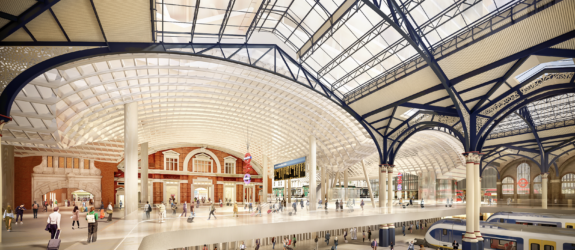Over £1.5 billion transformation of Liverpool Street Station to deliver a new world-class transport interchange and new landmark destination

– £450 million upgrades to alleviate access, capacity and overcrowding issues to transform the passenger experience for millions of station users
– Improving transport infrastructure seen as an essential part of helping the City of London maintain its position as a global centre of business
– Commercial elements ensure station improvements are delivered at no cost to the taxpayer or fare payer
Sellar, the developer of London Bridge Quarter and Paddington Square, and MTR, a leading global operator of sustainable rail transport services including the Elizabeth line, in partnership with Network Rail, have revealed their initial plans for vital upgrades to Liverpool Street station as part of a new sustainably developed office, retail and leisure scheme with new public and green spaces. Sellar, MTR and Network Rail are working closely with key stakeholders including Transport for London and the Hyatt, owners of the Andaz London Liverpool Street hotel adjacent to the station, to bring forward plans for this regeneration opportunity.
The vision for Liverpool Street station is being developed in collaboration with Pritzker Prize winning architectural practice Herzog & De Meuron, with the over £1.5 billion project aiming to create a world-class transport hub and landmark seven-day-a-week destination in its own right, delivering a new retail and leisure hub for visitors, passengers, and the local community.
Alleviating congestion and improving the station experience for 135 million station users a year
Originally fully opened in 1875, and London’s busiest station, Liverpool Street serves seven Underground lines, the Elizabeth line, London Overground and Greater Anglia services to destinations including Norwich, Cambridge and Stansted airport. The station underwent a major upgrade in the late 1980s and with around 135 million1 passengers passing through it annually in recent years, more than the pre-pandemic annual passengers at Heathrow Airport2.
As a result, Liverpool Steet Station suffers from significant overcrowding, poor pedestrian accessibility and connectivity into and within the station. As passenger numbers are set to increase Network Rail expect current conditions to worsen as it regularly exceeds its operating capacity. Furthermore, accessibility is severely limited with no provision for step-free interchange with London Underground and just one Disability Discrimination Act compliant lift serving the entire station.
A £450 million programme of significant infrastructure works are proposed and funded through the private sector partnership, by delivering an accompanying mixed use commercial development, which will unlock these issues and future-proof it for the years to come.
Major focus on improving accessibility and reducing congestion will save millions of passenger hours annually
Improving accessibility and speed of transit will be further improved through the provision of step-free access across the station and to all London Underground platforms. This will be addressed by increasing the number of lifts from one to seven, including six more escalators to bring the total to 10 and improving the London Underground station concourse and entrance.
Adopting a one station approach to the multiple transport modes with a clear focus on customer facilities will deliver significant improvement for passengers, visitors, office occupiers and the wider community.
Protecting and celebrating the station’s unique heritage features
Working sensitively with the station’s heritage features is also a key priority. The historic elements and façade of the Grade II listed Andaz hotel, which originally opened as the Great Eastern hotel in 1884, will be sensitively restored. The building will be sensitively and sustainably adapted so it connects to the concourse and creates a new public realm. This will also allow its historic rooms, including the masonic temples and ballroom, to be more accessible to the public, providing unique meeting, leisure, and exhibition space.
Existing memorials such as the Great War memorial and other statues will also be conserved and given more prominence. The ‘Kindertransport – The Arrival’ statue that serves as a memorial to the thousands of unaccompanied European Jewish children who fled to London on the Kindertransport in the Second World War will be restored and maintain its place in an upgraded Hope Square.
Read the press release in full.



